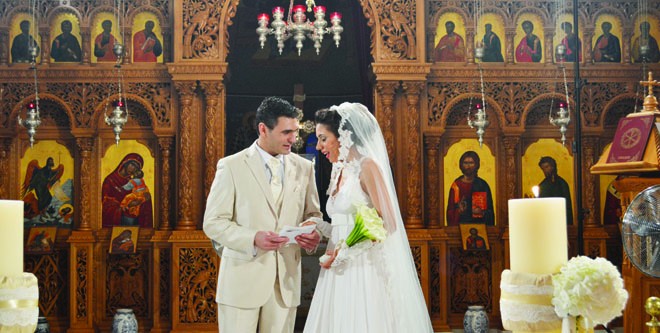
An occasion steeped in alien customs and tradition and yet so familiar

On a recent visit to Greece to attend a wedding, a vivacious group of people that welcomed us warmly reminded me of a joyful Punjabi family -- and how I felt acquainted with their matrimonial customs, especially their gossip of terribly intrusive mothers-in-law and sisters-in-law with little taste.
To me, then, Greece felt like home away from home.
The family and friends that had gathered for the wedding, and were waiting for the bride get ready and pose for the photo-shoot, were offered sugar-coated almonds, Koufeta, the sweetness of which symbolises the sweetness of the married couple’s future life. Koufeta was packed in ceramic cases. The parallel images of mithai we share with our near and dear ones at times of celebration pleasantly came to my mind then.
We then proceeded to the church, where it was customary to wait till the bride arrived. The bride came in after the group, a little late to give the groom a doubt that she may not ever arrive. But, perhaps, the late entry is a cliché, for the groom wasnexactly distressed.
The bride arrived in a white vintage car decorated with net and white roses. From there, she walked down an aisle up to the entrance of the church from where her father gave her arm over to her fiancé.
The Orthodox wedding ceremony consists of two halves -- the Service of Betrothal and the Service of Crowning. Contrary to what I expected, the bride and groom did not exchange vows. Rather, it was their presence before the Christ through the priest that signified their wish for a union.
The ceremony consisted of a series of occurrences steeped in ritual and symbolism that ensured the sacrament of their alliance.
During the Service of Betrothal, the priest asking for the God’s blessings on the couple recited several prayers. The wedding rings were placed on the fingers of their right hand, which held special connotations in the Orthodox faith. The Koumbara (maid of honour) exchanged the rings thrice, further emphasising the bride and groom union. This service closed with a final prayer by the priest.
The Service of Crowning then followed, which is the focal point in the ceremony, where the priest placed crowns on the heads of the bride and groom, signifying the honour and glory God is crowning them with and joined them by a ribbon to symbolise unity. The blessed crowns, Stefana, are interchanged between the couple thrice by the Koumbara, as a witness to the sealing of the union.
The rites of crowning are followed by a recitation of the Gospel, which followed with the newlyweds being given wine in a ‘common cup’ to denote the mutual sharing of joy and sorrow from this moment on. The priest then leads the bride and the groom in a circle around a table on which the Gospel, the Cross, the Common Cup and Koufeta are placed. This walk marks their first steps as a married couple.
At the conclusion of the ceremonial walk, the priest removes the crowns and separates their joined hands under the Gospel, as only the God can break their bond.
This marks the end of the ceremony at the church. The guests are given rice to throw at the newly married couple so they can grow roots together and be blessed with fertility and abundance. Their walk back to the adorned car formed a slightly similar image in my mind, as at our baraat flowers are thrown on the couple.
The wedding ended with a reception, where we were seated on assigned tables. The lively character of the Greeks, which was restricted in church, suddenly came to life. Sitting with strangers, I found them to be individuals particularly easy to talk to.
With cuisine and music being the key elements in a desi shadi, I could understand the concerns one places towards them. However, I hardly thought such a worry to extend to Greece. The bride fretted over the ample supply of mouth-watering dishes in a way all too native. Meanwhile, the latest hits blared in the background.
Soon after, live music started and several people got up to dance. I expected a form of ballroom dancing. Surprisingly, they danced an ethnic dance, Horos, in a circular arrangement, which was exactly like our luddi.
According to the frolicsome Greeks, a wedding is a success only if the party continues till morning, and it did. Probably because I had to leave the following day at 7 am, the rest of the night went by in a daze of loud music, laughter and cheers.
With undeniable similarities, one aspect remained certain -- it wasn’t exactly all Greek to me.